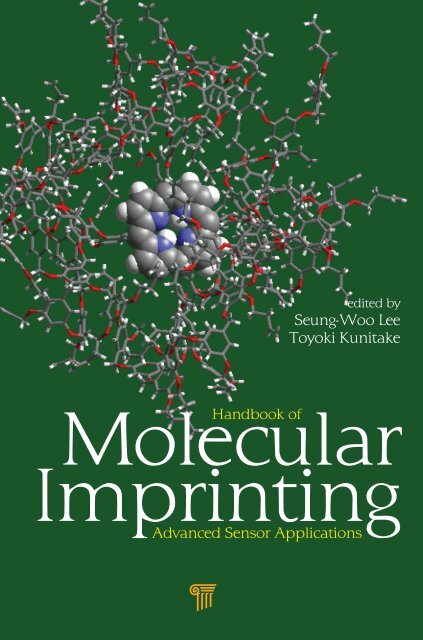Download PDF - Pan Stanford Publishing
Download PDF - Pan Stanford Publishing
Download PDF - Pan Stanford Publishing
- No tags were found...
You also want an ePaper? Increase the reach of your titles
YUMPU automatically turns print PDFs into web optimized ePapers that Google loves.
Published by<strong>Pan</strong> <strong>Stanford</strong> <strong>Publishing</strong> Pte. Ltd.Penthouse Level, Suntec Tower 38 Temasek BoulevardSingapore 038988Email: editorial@panstanford.comWeb: www.panstanford.comBritish Library Cataloguing-in-Publication DataA catalogue record for this book is available from the British Library.Handbook of Molecular Imprinting: Advanced Sensor ApplicationsCopyright © 2013 by <strong>Pan</strong> <strong>Stanford</strong> <strong>Publishing</strong> Pte. Ltd.All rights reserved. This book, or parts thereof, may not be reproduced in any formor by any means, electronic or mechanical, including photocopying, recordingor any information storage and retrieval system now known or to be invented,without written permission from the publisher.For photocopying of material in this volume, please pay a copying fee throughthe Copyright Clearance Center, Inc., 222 Rosewood Drive, Danvers, MA 01923,USA. In this case permission to photocopy is not required from the publisher.ISBN 978-981-4316-65-1 (Hardcover)ISBN 978-981-4364-32-4 (eBook)Printed in the USA
ContentsPart 1Fundamentals of Molecular Imprinting andSensor Applications 11. Fundamentals and Perspectives of MolecularImprinting in Sensor Applications 3Seung-Woo Lee, Sergiy Korposh, Roman Selyanchyn, andToyoki Kunitake1.1 Introduction 31.2 Molecular Imprinting in Organic Matrices 41.2.1 Covalent Approach 61.2.2 Non-Covalent Approach 71.2.3 Other Approaches for OrganicMIP Fabrication 91.3 Molecular Imprinting in Inorganic Matrices 111.3.1 Sol-Gel Approach 121.3.2 Liquid Phase Deposition (LPD) Approach 151.4 Major Transducers 161.4.1 Mass-Sensitive Transducer 171.4.2 Electrochemical Transducer 191.4.3 Optical Transducer 211.5 Applications of Organic MIP Materials in Sensors 261.6 Applications of Inorganic MIP Materials in Sensors 311.6.1 Silica Based Imprinted Materials 311.6.2 Hybrid Imprinted Materials 381.6.3 LPD Based Imprinted Materials 401.6.4 Strategy for Improved Selectivity 431.7 Conclusions 452. Molecularly Imprinted Optical Sensing Receptor 65Sing Muk Ng and Ramaier Narayanaswamy2.1 Introduction 652.2 Chronological Protocols and Procedures 67
viContents2.2.1 Selection of Materials and Ingredients 672.2.2 Polymerization Options 722.2.2.1 Free-radical initiatedpolymerization 722.2.2.2 Condensation polymerization 732.2.2.3 Electropolymerization 742.2.3 Configurations of Matrix 752.2.3.1 Bulk 752.2.3.2 Monoliths 762.2.3.3 Membranes 772.2.4 Handling and Preparation 782.3 Rational Design of Receptors 792.3.1 Interaction Study of Pre-PolymerizationIngredients 792.3.2 Computational Modeling 812.3.3 Thermodynamic Considerations 832.3.4 Repeatability and Reproducibility 862.3.5 Commercialization 872.4 Optical Sensing Schemes and TransductionSystems 892.4.1 Direct Monitoring of Analyte 892.4.2 Direct Fluorescence 902.4.3 Displacement Assay 922.4.4 Reflectance and Absorbance 942.4.5 Phosphorescence 962.4.6 Chemiluminescence 972.4.7 Surface Plasmon Resonance 982.4.8 Fluorescence Lifetime Decay 1002.5 Advanced Probe Designs and SensingConfiguration 1022.5.1 Sensor Arrays 1022.5.2 Optical MIP Chips 1042.5.3 Micro- and Nano-sized Sensors 1062.6 Binding Aspects and Analytical Signals 1082.6.1 Binding Isotherms and AffinityDistributions 1082.6.2 Batch Binding Analysis and BindingModels 109
Contentsvii2.6.3 Correlation of Analytical Signal withBinding Isotherms Models 1102.6.4 Advantage and Limitation 1112.7 Summary 1123. Translational Applications of MolecularlyImprinted Polymer-Based ElectrochemicalSensors 119Hung-Yin Lin, James L. Thomas, and Mei-Hwa Lee3.1 Introduction 1193.2 Principle of Molecularly Imprinted Polymers 1213.2.1 Synthesis of MIPs 1213.2.2 Characterization of MIPs 1233.2.3 Morphology of MIPs 1243.3 Transducers Employed with MolecularlyImprinted Polymers as Sensing Elements 1263.3.1 Types of Transducers 1263.3.2 Interface of Transducer and MolecularlyImprinted Polymers 1303.3.3 Miniature MIPs-Based Sensors 1303.3.4 Demonstration of MIPs-BasedElectrochemical Sensors 1343.4 Molecularly Imprinted Polymers-Based Sensorsfor the Real World 1353.4.1 Source of Real Samples 1353.4.2 Biomarkers 1383.4.3 Cross-Talk Interference 1383.5 Prospective 1394. Optical Sensors for MonitoringTrace InorganicToxins 147T. Prasada Rao, Dhanya James, and Milja T. Elias4.1 Environmental Trace Analysis 1484.2 Inorganic Toxins 1484.3 Importance of Sampling in Trace Analysis 1524.3.1 Sample Handling 1524.3.2 Sample Pre-Treatment, Homogenizationand Sub-Sampling 1524.3.3 Sample Preparation 152
viiiContents4.3.3.1 Decomposition of inorganic ororganic matrices 1534.3.3.2 Separation and pre-concentrationsteps 1534.4 Trace/Ultra Trace Analytical Techniques 1544.4.1 Selection of Analytical Technique/Method 1574.4.2 Essential Features of AnalyticalTechniques 1584.4.2.1 Signal processing, data handlingand reporting 1584.4.2.2 Signal integrity 1584.4.2.3 Data handling 1584.4.2.4 Good Automated LaboratoryPractice (GALP) [1] 1594.4.2.5 Reporting of results 1594.5 Chemical Speciation 1604.6 Sensors 1614.6.1 Fundamentals of Optical Sensors(Optodes) 1634.6.2 Optical Sensing of Ionic Analytes 1634.6.3 Optical Sensing of Neutral Analytes 1654.7 Molecularly Imprinted Polymers 1664.7.1 Molecular Imprinting Technology 1674.7.2 MIPs in Optical Sensing 1684.8 Optical Sensors vis-a-vis Other Sensor Techniques 1744.9 Future Outlook 1745. MIP Thermistor 181Rajagopal Rajkumar, Umporn Athikomrattanakul,Kristian Lettau, Martin Katterle, Bengt Danielsson,Axel Warsinke, Nenad Gajovic-Eichelmann, andFrieder W. Scheller5.1 Introduction 1815.1.1 The MIP Concept 1815.1.2 MIP Sensors 1835.1.3 Enzyme Thermistors 1845.2 Covalently Imprinted Polymers Using BoronicAcid Derivates 1885.2.1 Synthesis of Template (Fructosyl Valine) 189
Contentsix5.2.2 Synthesis of Functional Monomer (VinylPhenyl Boroxine) 1895.2.3 Synthesis of N-[β-D-Fructopyranosyl-(1)]-L-Valine2,3; 4,5-bis-O- ((4-Vinylphenyl)Boronate) 1905.2.4 Synthesis of MIP and Control Polymers 1905.2.5 MIP Thermistor Set-Up and Measurements 1905.2.6 Thermometric MIP Sensor for Fructose 1915.2.7 Thermometric MIP Sensor for FructosylValine 1935.2.8 Concentration Dependence of Fru-ValBinding 1945.2.9 Closed Loop Studies 1965.3 Non-Covalent MIPs Containing Two FunctionalMonomers for Carboxyphenyl Aminohydantoin(CPAH) as Analogon of Nitrofurantoin (NFT) 1975.3.1 Synthesis of an Analogue Template,Carboxyphenyl Aminohydantoin (CPAH) 1975.3.2 Synthesis of Functional Monomers 1985.3.3 Preparation of MIPs Based on TwoFunctional Monomers 1995.3.4 MIP-Based Thermometric Study 2005.4 Bi-Functional Esterolytically Active MIP 2035.4.1 Polymer Preparation 2045.4.2 Thermometric Characterization ofAdsorption and Catalysis 2055.5 Conclusions 209Part 2Potential Materials for MolecularImprinting 2176. The Use of a Thermally Reversible Bond forMolecular Imprinting 219Ji Young Chang6.1 Introduction 2196.2 Cross-Linked Vinyl Polymer Matrix 2216.3 Silica Matrix 2266.4 Polyimide as Noncross-Linked Matrix 2286.5 Summary and Outlook 232
xContents7. Molecular-Sieving Silica/Tin Oxide SensorPrepared by Chemical Vapor Deposition in thePresence of Template Molecule 235Naonobu Katada and Miki Niwa7.1 Introduction 2357.2 Preparation Method 2387.3 Selective Chemisorption 2417.4 Sensing Function 2447.4.1 Selectivity for Various Molecules 2447.4.2 Improved Response and Selectivity ofFilm-Type Sensor 2497.4.3 Detection of Dialkyl Phthalate 2527.5 Conclusion 2548. Environmental Approaches by MolecularImprinting on Titanium Dioxide 259Milka Nussbaum and Yaron Paz8.1 Introduction 2608.2 Preparation 2698.2.1 Preparation of Molecularly Imprinted (MI)Structures 2698.2.1.1 Sol-gel method using alkoxidechemistry 2718.2.1.2 “Layer-by-layer” approach usingsol-gel method 2728.2.1.3 Liquid phase deposition/chemicalbath deposition 2748.2.1.4 Titanyl sulfate chemistry 2758.2.1.5 Titanium tetrachloride chloridechemistry 2768.2.1.6 Potassium titanyl oxalatechemistry 2768.2.2 Preparation of Molecularly ImprintedPolymer (MIP) Structures 2768.2.3 Preparation of Molecularly ImprintedInorganic (MII) Structures 2778.2.4 Preparation of Molecularly ImprintedHost (MIH) Structures 2788.3 Characterization 279
Contentsxi8.3.1 Interaction Between Host and Template 2798.3.2 Assessment of Removal of TemplateMolecules 2818.3.3 Concentration and Structure of Sites 2828.3.4 Surface Area 2828.3.5 Film Morphology and Particles’ Size 2838.3.6 Film Thickness 2838.3.7 Crystalline Phase 2848.4 Applications 2848.4.1 Sensing 2848.4.1.1 Quartz crystal microbalance(QCM) sensors 2858.4.1.2 Electrochemical sensors 2868.4.1.3 Ion sensitive field effecttransistors 2888.4.1.4 Matrix-assisted laser desorption/ionization (MALDI)massspectrometry2908.4.1.5 Evaluation of performance ofsensors 2908.4.1.5.1 Sensitivity 2918.4.1.5.2 Imprinting efficiencyratio 2918.4.1.5.3 Selectivity 2938.4.1.5.4 Response time 3038.4.1.5.5 Repeatability 3048.4.1.5.6 Stability andreproducibility 3048.4.2 Photocatalysis 3058.4.2.1 Introduction 3058.4.2.2 Performance 3078.4.2.2.1 Efficiency 3088.4.2.2.2 Selectivity 3108.4.2.2.3 Adsorption vs.photocatalyticdegradation 3138.4.2.2.4 Imprinting ofpseudo-target molecules 3168.4.2.2.5 Intermediates andby-products 318
xiiContents8.4.2.2.6 Stability andrepeatability 3198.4.3 Separation by Selective Filtration 3208.5 Conclusion 321Part 3MIP Sensors for Environmentaland Trace Detection 3319. Molecularly Imprinted Nanocomposites for HighlySensitive SPR Detection 333Jun Matsui and Kensuke Akamatsu9.1 Introduction 3339.2 Surface Plasmon Resonance of Metal Nanoparticles 3359.2.1 Biosensors Utilizing Gold Nanoparticles 3379.2.2 Synthesis of Surface-Functionalized GoldNanoparticles 3399.3 Molecularly Imprinted Nanocomposite 3409.3.1 Concept 3409.3.2 Colorimetric Sensing with MolecularlyImprinted Nanocomposite 3409.3.2.1 Physical properties 3429.3.2.2 Selectivity 3439.3.3 SPR Sensor with Molecularly ImprintedNanocomposite Gel 3449.3.3.1 Preparation of sensor chip 3459.3.3.2 SPR measurement 3469.3.4 SPR Sensing of Atrazine 3489.3.4.1 Preparation of sensor chip 3489.3.4.2 Effects of gold nanoparticles onsensitivity 3499.3.4.3 Effects of molecular imprintingon sensitivity 3509.3.4.4 Selectivity 3529.4 Conclusion 35310. Molecularly Imprinted Room TemperaturePhosphorescent Optosensors for EnvironmentalPollutants 359He-Fang Wang and Xiu-Ping Yan10.1 Introduction 359
Contentsxiii10.2 Fabrication of MIPs-Based RTP Optosensors 36110.2.1 Conventional MIPs with RTP Detection 36110.2.2 Incorporation of Heavy Atoms into MIPs 36410.2.3 Surface Imprinting on PhosphorescentNanoparticles 36810.3 RTP Detection Modes 37410.3.1 Static Measurement 37410.3.2 Flow-Through Assays 37710.4 Applications 37910.4.1 RTP Sensing of Nafcillin 37910.4.2 RTP Sensing of PAHs 38110.4.3 Sensing of Copper Ions 38210.4.4 Sensing of Pentachlorophenol 38310.5 Conclusions 38411. Electrochemical Sensing of NitroaromaticCompounds in Natural Waters and Soil Samples 389Taher Alizadeh11.1 Introduction 38911.2 Nitroaromatic Compounds 39011.3 Different Strategies Developed for Preparationof MIP for Nitroaromatic Compounds 39211.4 Electrochemistry of Nitroaromatic Compounds 39811.5 MIP-Based Electrochemical Sensors 40011.5.1 Polymerization Directly on the ElectrodeSurface 40111.5.1.1 Sol-gel and poly TiO 2 systems 40111.5.1.2 Electrodes modified withelectropolymerized films 40511.5.2 Coupling of the MIP Particles withElectrochemical Transducers 40711.5.3 MIP as a Solid Phase Sorbent forSeparation and PreconcentrationBefore Electrochemical Determination 41312. Trace Detection Based on Cyclodextrin AnchoredMolecularly Imprinted TiO 2 Thin Films 421Seung-Woo Lee12.1 Introduction 42112.2 Surface Sol-Gel Process and Molecular Imprinting 423
xivContents12.3 Two-Dimensional Imprinting with JuxtaposedCD Hosts on Metal Oxide Surface 42612.3.1 BPA Sensing Based on ElectrochemicalImpedance Changes 42712.3.2 SAM Effects on cSPI Response 42912.3.3 cSPI Response to BPA on a BPA-ImprintedTiO 2 /β-CD Film 43112.3.4 Selectivity of the BPA-ImprintedTiO 2 /β-CD Film 43312.4 Trace Detection of Explosives Using a CD-AnchoredMetal Oxide Matrix 43512.4.1 Surface Modification for 2,4-DNTRecognition 43612.4.2 cSPI Response and Sensitivity to 2,4-DNT 43712.5 Imprinting Process Associated with a Gas PhaseSol-Gel Technique 43912.5.1 Gas-Phase Surface Sol-Gel (GSSG) Process 43912.5.2 Three-Dimensional Assembly ofTemplated CDs with TiO 2 Ultrathin Layers 44012.5.3 BPA Response and Imprinting Effect 44112.6 Future Prospects 44413. Molecularly Imprinted Au Nanoparticle Compositesand Their Application for Sensing, ControlledRelease, and Photoelectrochemistry 453Itamar Willner and Ran Tel-Vered13.1 Introduction 45313.2 Imprinting of Molecular Recognition Sites in AuNP Composites via Donor–Acceptor and/orElectrostatic Interactions 45613.3 Imprinted Ligand-Functionalized bis-Aniline-Crosslinked Au NP Composites for Sensing 46213.4 Electrochemically Triggered Imprinted Au NP“Sponges” 46713.5 Controlling the Wettability of Surfaces byImprinted Au NP Composites 47113.6 Imprinted Semiconductor Nanoparticle/Metal Nanoparticle Composites for EnhancedPhotoelectrochemistry 474
Contentsxv13.7 Conclusions and Perspectives 476Part 4 Bio-Medical Applications of MIP Sensors 48514. Protein-Sensing Using Organic/Inorganic HybridMaterials Prepared by Liquid-Phase Deposition-Based Molecular Imprinting 487Toshifumi Takeuchi14.1 Introduction 48714.2 Liquid-Phase Deposition 48914.3 Cationic Polyions/Titanium Oxide Hybrid Materialsfor Acidic Protein Recognition 49014.4 Anionic Polymer/TiO 2 Hybrid Materials for BasicProtein-Sensing 49214.5 Protein Imprinting on Quantum Dots by LPDMethod 49314.6 Conclusion 49415. Molecular Imprinted Polymer-BasedChemiluminescence Sensors 499Zhujun Zhang15.1 Introduction 49915.2 Molecular Imprinted Polymer-BasedChemiluminescence Flow Sensors 50315.3 Molecular Imprinted Polymer-BasedCL ImagingSensors 51215.4 Molecular Imprinted Polymer-BasedChemiluminescence Biosensor Chips 51715.5 Molecular Imprinted Polymer Recognition andOnline Electrogenerated ReagentChemiluminescence Detection 51916. Detection of Cells and Viruses Using SyntheticAntibodies 527Adnan Mujahid, and Franz L. Dickert16.1 Introduction 52816.2 Molecular Imprinting for Biomolecules 53016.3 Synthetic Antibodies for Cells Detection 53216.3.1 Yeast Cells 533
xviContents16.3.2 Blood Cells Detection 53716.3.3 Bacterial Detection Through SyntheticMaterials 54116.4 Imprinted Materials – A novel tool for VirusSensing 54716.4.1 Tobacco Mosaic Virus (TMV) Imprinting 54816.4.2 Parapox Ovis Virus (ORF) Sensing 55116.4.3 Bovine Leukemia Virus Imprinting 55216.4.4 Molecular Imprinting for Picornaviruses 55316.4.5 Dengue Virus Detection Through EpitopeImprinting Approach 55516.4.6 Poliovirus Detection by Imprinted SAMs 55716.4.7 Virus Sensing by MIP-CoatedMicrosensors 55816.5 Concluding Remarks and Future Outlook 559Part 5 MIP Market and Prospects 56917. Molecularly Imprinted Polymers: Science GoesMarket? A Market Analysis Based on the PatentSituation 571Soeren Schumacher17.1 Introduction 57317.2 Methods 57417.3 Results and Discussion 57517.3.1 Patent Activity 57517.3.2 Application Areas 58017.3.3 Citation Analysis 58017.3.4 S-Curve Consideration 58617.3.5 Company Overview 58717.3.6 Patent Portfolio of Companies 59117.3.7 Competitive and SWOT Analysis 59117.4 Conclusion 594Index 599
ContentsxviiPrefaceMolecular imprinting is now established as an indispensable toolfor separation and sensor technologies. The most popular schemeto realize the molecular imprinting concept is probably the crosslinkingof linear polymers in the presence of template molecules.Three-dimensional cavities would be created in the polymernetwork after the removal of template molecules. Unfortunately,the conformational adaptability of linear polymers is limited, andtemplate molecules and the surrounding polymer chains cannotproduce best molecular fitting in most cases. Molecular fitting bycommonly employed imprinting materials is less than satisfactorycompared with polypeptide chains of protein molecules. Superiorthree-dimensional fit of active sites of enzyme molecules and theirspecific substrates are truly remarkable.Some of the inorganic chains are much more flexible than organicchains. For example, rotational and bending motions of metal–oxygenbonds are more facile than those of carbon–carbon bonds. Thisfact implies that metal oxide gels provide better molecular fittingwith template molecules. In fact, the first example of molecularimprinting was reported in 1931 for silica matrix, as mentioned inChapter 1. The use of inorganic matrices became much expandedin recent years and now occupies a significant fraction of molecularimprinting studies.This handbook reflects this situation and attempts to survey therecent advances of molecular imprinting in inorganic and organicmatrices in a combined form. The functional aspect is more or lessfocused on sensor applications. Such applications have becomeincreasingly important in relation to environmental and biomedicalissues, as summarized as Parts 3 and 4, respectively. The discussionin Chapter 1 will help grasp the pros and cons of inorganic matricesrelative to organic matrices, and Part 5 provides a patent-basedmarket analysis of molecular imprinting technology.We are grateful to Mr. <strong>Stanford</strong> Chong of <strong>Pan</strong> <strong>Stanford</strong> <strong>Publishing</strong>for his continuous encouragement during the preparation of thishandbook. Many thanks also to our wives, who showed splendidperseverance towards the absent (minded) husbands.
















